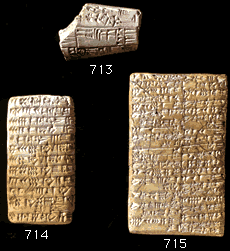| |
The lands of "Dilmun", "Magan" and "Meluhha" that are mentioned in Mesopotamian cuneiform tablets are believed to be Bahrain, Oman and the Indus Civilization, respectively. The various goods traded from east to west, as well as from west to east, surely spread beliefs and philosophies along with material goods.

 Inscriptions on clay Inscriptions on clay
713: Cone inscription of Ur-Nammu, king of Ur (2112-2095 B.C.) mentioning ships of Magan (Oman). From Ur, Ur III period.
714: Cuneiform tablet listing the cargo of a boat going to Magan. From Lagash (Girsu), Ur III period, circa 2100 B.C.
715: Cuneiform tablet recording the inventory of deposits of barley available for distribution, including one in a granary in the village of Meluhha. This village was located in the old city-state of Lagash. The name presumably reflects the fact that the original founders or inhabitants of the village came from Meluhha. From Lagash, Ur III period, dated to 2047 B.C.
|


